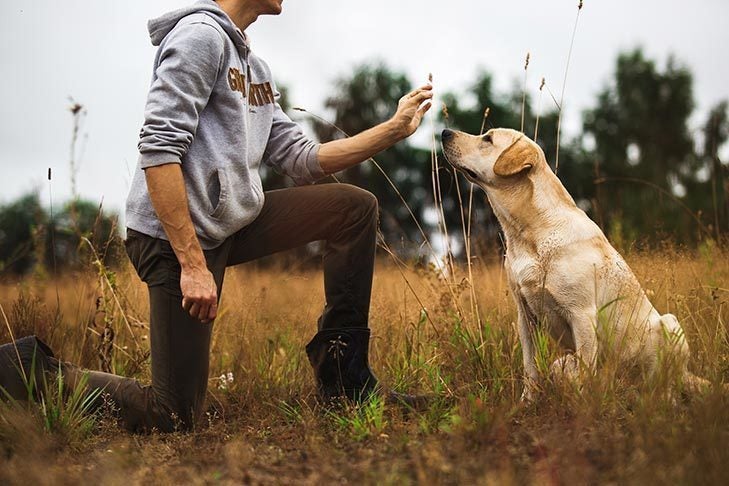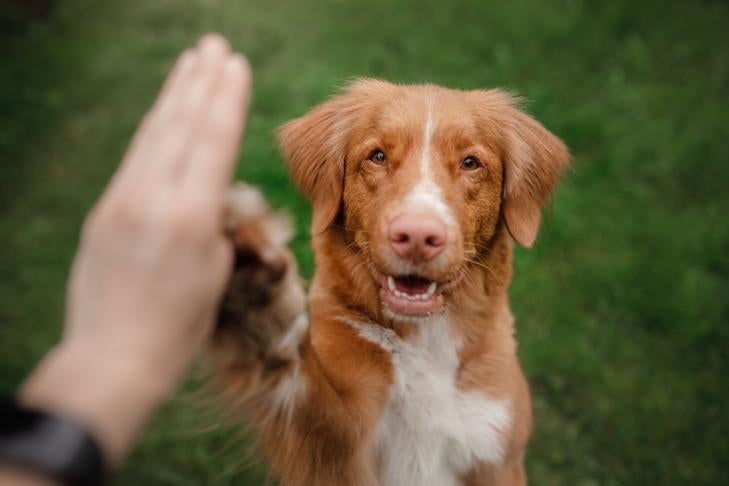What Is the Meaning of the Click?
The clicker is merely a way to mark a moment. There is nothing magical about that specific noise, except that you likely never make it around your dog outside of training. Therefore, you can substitute anything as a marker as long as it’s distinct from other ways you communicate with your dog. For example, you could snap your fingers, blow a whistle, or cluck your tongue. Many people use a marker word, like “Yes” or “Good.” For a hearing-impaired dog, you could use a light or a gentle tap on the shoulder.

Of course, the click or other marker itself is meaningless until it’s paired with a reward. The click simply indicates a reward is on the way. Although edible treats are the best incentive for most dogs, a reward is anything your dog values. So if your pup would rather work for a game of tug-of-war than a chunk of chicken, play that instead. The important part is timing and consistency. The click must mark the correct moment and every click must be followed by a reward.
In positive reinforcement training, a dog is rewarded after performing a desirable behavior. Without the use of a clicker or other marker, it might be obvious to the trainer what is being rewarded, but is it obvious to the dog? For example, when teaching a dog to lie down, how do you make it clear you are rewarding the belly on the ground? You have to make sure the reward is given while the dog is lying down rather than the dog getting up to get it. Otherwise, the dog might think the reward is for standing up or walking toward you. That’s easy with food treats, but impossible if the reward is a round of fetch or tug.
What about dogs who pop up from a down as soon they touch the floor? You can’t possibly get the reward to them fast enough. Or, what about more challenging behaviors like those performed at a distance? How do you get your dog a reward for jumping through a hoop at the exact moment they pass through the hoop? That’s where the power of the click or other marker comes in. The click marks the moment you are going to reward, then bridges the gap in time until the reward arrives. Your dog knows exactly what action was correct.
But couldn’t you just use praise in the same way? You could, but it’s not nearly as clear. You communicate with your dog using praise all the time. In fact, it’s a wonderful part of rewarding your dog. Plus, there is nothing about praise that is specific to the training situation, nor would you want that to be the case. Gushing over your dog is part of the joy of dog ownership. Using a clicker or other training-specific marker prevents confusion about the reward to come.
On top of the benefit of clarity, clicker-trained dogs tend to love learning. They want to train and work hard to earn a click. From your dog’s point of view, mark and reward training makes teaching new behaviors a game. It takes the pressure off the trainer too. Looking for clickable moments means you focus on your dog’s good choices, rather than dwelling on mistakes. Like any form of positive reinforcement training, clicker training boosts your communication, builds your bond with your dog, and makes training fun.

Help us keep pets and owners together
The cost of living crisis has left thousands of people unable to afford their pet’s care. Often, we are their only emergency service.
Clicker training is a type of reward based training where a clicker is used to tell your dog that they have done the right thing. Clicker training works because your dog learns to associate one thing (the click) with another (the reward such as a treat). Eventually the clicker itself becomes a reward. A click is always followed by a reward at first to help your dog understand it’s a good thing. Over time you can reduce how often they get a separate reward as the click becomes a reward in itself.
The idea behind using a clicker instead of using a reward alone is so your dog knows exactly when they did the right thing. Some people prefer this over traditional training as it can help dogs learn faster. This is because when you reward a dog using traditional methods for something like sitting, they may have, for example, stood up or done something else by the time you reward them. This can be confusing as they might think they got the reward for that. In clicker training, the sound of the click is used as a ‘mark’ for good behaviour. It pinpoints the exact moment your dog has done the right thing so they don’t get confused.
The other advantage is if your dog prefers food rewards, clicker training helps to avoid obesity as less treats are needed once the clicker starts to be its own reward.
Watch Now: How to Clicker Train Your Dog
Clicker training lets your puppy stumble upon the behavior you want him to do. He will perform many “wrong” behaviors before he accidentally sits—and gets a reward. The puppy figures out that he’ll get a reward if he can guess—and perform—the behavior you want. The more wrong behaviors he tries, the better he learns what won’t work. You don’t use commands or physical direction with clicker training, it’s all puppy motivated, so the puppy never gets punished—but he’s only rewarded for the right choice.
Here’s how it works. Instead of waiting for your puppy to do something wrong, catch him doing something right. Mark that behavior with a distinctive signal so the puppy understands THAT action (the sit, for example) is what you like. You can use a special word like YES!, or a signal like a click from a clicker. The clicker simply explains to the puppy he was right. Then reward him with praise, treats, or a toy. Choose whatever floats your puppy’s boat, and reserve the most prized reward for these training sessions.